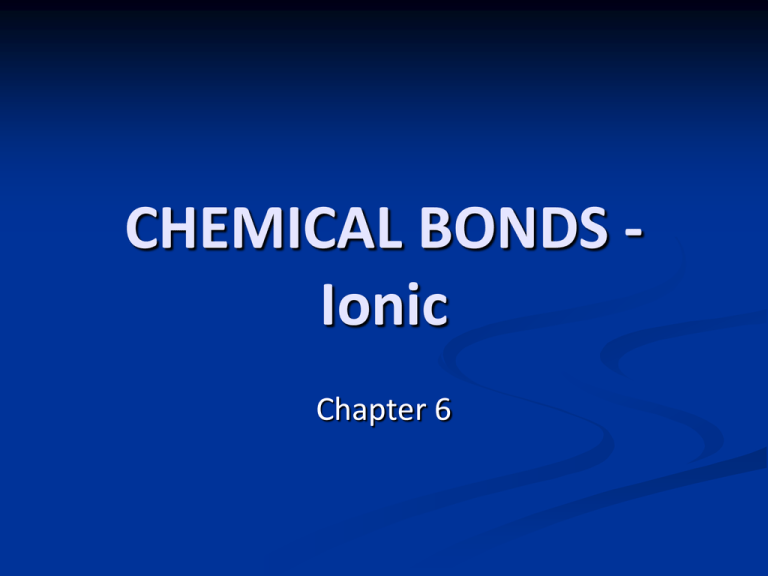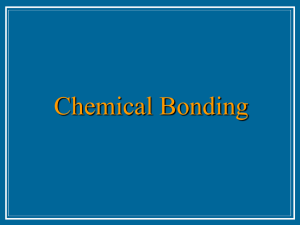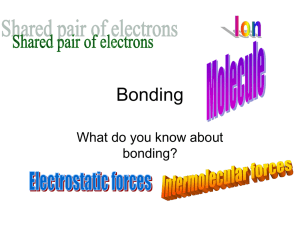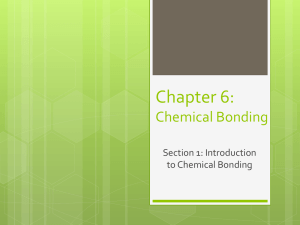ionic bonding powerpoint
advertisement

CHEMICAL BONDS Ionic Chapter 6 6.1 BONDING - journal 1. Begin filling in the table on the top of the Bonding Basics – Ionic Bonding Worksheet. 6.1 BONDING Chemical PROPERTIES depend on the number of valence electrons. 6.1 BONDING Therefore, chemical bonding and reactivity depend on an element’s electron configuration. 6.1 BONDING STABLE ELECTRON CONFIGURATION: Which group does this describe? 6.1 BONDING What do elements with UNSTABLE ELECTRON CONFIGURATIONS do? 6.1 BONDING They BOND and form compounds IONIC BONDING 6.1 BONDING IONIC BONDING – the forming of a stable electron configuration through electron transfer Both Sodium and Chlorine are now STABLE in their highest energy levels 6.1 BONDING IONIC BONDING – the forming of a stable electron configuration through electron transfer What types of elements are Sodium and Chlorine? 6.1 BONDING IONIC BONDING – the forming of a stable electron configuration through electron transfer between a metal and a nonmetal. 6.1 BONDING IONIC BONDING – the forming of a stable electron configuration through electron transfer between a metal and a nonmetal. When an atom gains or loses electrons, what does it get? A CHARGE. 6.1 BONDING IONIC BONDING – the forming of a stable electron configuration through electron transfer between a metal and a nonmetal ION: An atom with a positive or negative CHARGE from electron transfer. 6.1 BONDING IONIC BONDING – the forming of a stable electron configuration through electron transfer between a metal and a nonmetal In the bond, one becomes positive (loses electrons) and one becomes negative (gains electrons). 6.1 BONDING IONIC BONDING – the forming of a stable electron configuration through electron transfer between a metal and a nonmetal Positive Ion (loses electrons): Cation Negative Ion (gains electrons): Anion 6.1 BONDING IONIC BONDING – the forming of a stable electron configuration through electron transfer between a metal and a nonmetal WHAT DO OPPOSITE CHARGES DO? 6.1 BONDING IONIC BONDING – the forming of a stable electron configuration through electron transfer between a metal and a nonmetal ATTRACT. This is when the IONIC BOND forms. 6.1 BONDING HOW can you predict which elements will make positive cations and which will make negative anions? 6.1 IONIC BONDING Ionization Energy: the ability to PULL ON ELECTRONS. Look at “Data Analysis” at the top of page 160. Which side has the MOST PULL? Which side GIVES UP electrons more easily? 6.1 IONIC BONDING Ionization Energy: the ability to PULL ON ELECTRONS. Take out your Periodic Table. Predict the OXIDATION NUMBERS (charges) of the ions for A Groups 6.1 IONIC BONDING PROPERTIES OF IONIC COMPOUNDS 1. Form between a metal and a nonmetal 2. Brittle/crystalline 3. High melting/boiling points Dissolve (ions come apart) in water & conduct electricity 4. 6.1 IONIC BONDING NAMING IONIC COMPOUNDS 1. NaCl – Sodium Chloride 2. HF – Hydrogen Fluoride 3. MgI2 – Magnesium Iodide 4. KBr - ??? Potassium Bromide This is Binary Nomenclature Ionic Bonding Challenge IONIC BONDING POLYATOMIC IONS Sometimes groups of atoms can have a positive or negative charge. COMMON POLYATOMIC IONS 1. NH4+ – Ammonium 2. NO3- – Nitrate 3. OH1- - Hydroxide 4. CO32- – Carbonate 5. SO42- - Sulfate 6. PO42- - Phosphate 6.1 IONIC BONDING 1. NAMING COMPOUNDS WITH POLYATOMIC IONS CaCO3 1. 2. HNO3 1. 3. Hydrogen nitrate (nitric acid) NH4Cl Ammonium chloride 1. 4. Calcium carbonate NaOH 1. Sodium hydroxide 6.1 IONIC BONDING 6.1 IONIC BONDING – Journal 2 Ionization Energy: the ability to PULL ON ELECTRONS. FOLLOW THE DIRECTIONS AT THE TOP OF THE BLANK PERIODIC TABLE FROM THE BACK OF THE ROOM. 6.1 BONDING – Journal 2 Define ionic bond Define ionization energy Take out your Ionic Bonding basics worksheet and make sure you have a Lewis Dot for each element on the page, front and back Begin filling out the Covalent Bonding Basics Table








